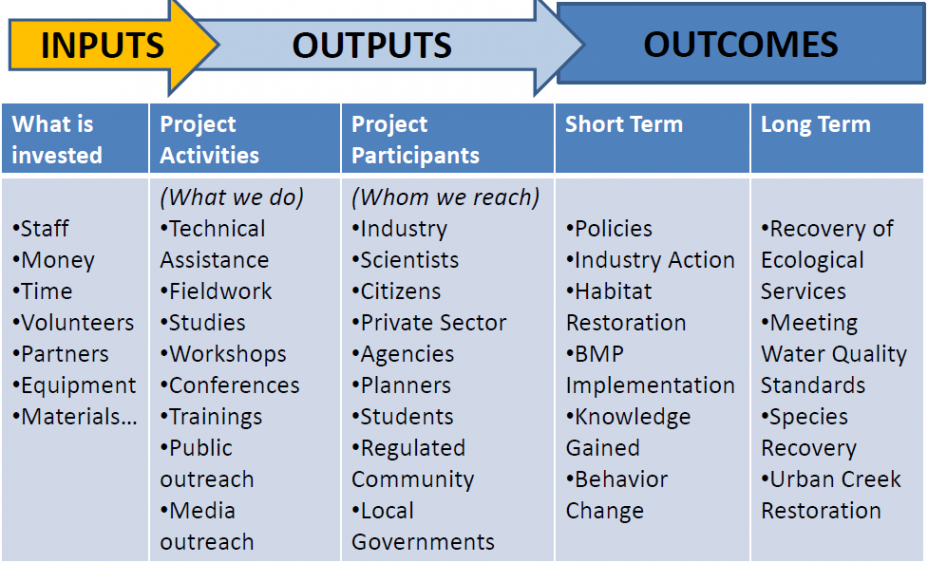RFA Application Assistance
Environmental Results
Achieving significant environmental results is the top priority of the program. To maximize the benefits of these public investments, applicants for the SFBWQIF are asked to clearly define the anticipated environmental results, also known as outcomes, to be achieved by the proposed project. The most successful proposals begin with desired outcomes and plan activities to best achieve those outcomes, thereby ensuring a wise investment of public funds. Clearly defined outcomes are most likely to achieve significant water quality results.
EPA recommends applicants use a Logic Model to conceptualize anticipated environmental outcomes. The Logic Model is a planning tool to help identify activities needed to achieve desired outcomes. The model is a thought process by which one starts with the “big picture” environmental results desired and then works backwards in time to list specific activities needed to achieve those results. This list can then be broken down further to show what is achieved in the short term and how it contributes to longer term objectives. While it is not always possible to measure significant environmental outcomes within the life of a typical grant, it is essential to show how an individual project or grant contributes to achieving long term objectives. Logic Model tables with outputs and environmental results for each SFBWQIF project can be found on the project page and in Appendix B.
Outputs are the activities or deliverables that are to be accomplished as a result of a grant. Outputs are generally described as deliverables or milestones in a workplan or timeline. EPA project officers track the completion of outputs to monitor the progress of a grant. Outputs include things like workshops held, volunteers trained, studies, watershed management plans, outreach materials, etc.
Outcomes are the environmental impacts or results of the work of the grant. While outputs are accomplished during the life of the grant, outcomes may occur after the completion of the grant. It may be useful to categorize outcomes as short-term and/or long-term. Documenting environmental outcomes can be challenging, so a wide range of methods can be utilized including estimation, modeling and monitoring.
- Short-term outcomes may include things like: extent of installed best management practices, reduction in pesticide use, sediment load reductions to a waterbody, acres of wetlands restored, number of growers with water quality plans, changes to less polluting behavior, increase in knowledge, an active stewardship program, etc.
- Long-term outcomes might include: documented progress towards achieving TMDL water quality objectives, reduction of a pollutant in a waterbody or target species, recovery of ecological services in a wetland, meeting water quality standards, water body removal from 303(d) list because of active stewardship including use of BMPs, widespread implementation of LID as a result of demo projects and institutional changes, etc.
The Logic Model
The Logic Model is a planning tool to help design activities to achieve desired outcomes. While it is not always possible to measure significant environmental outcomes within the life of a typical grant, it is important to show the contribution of your individual project or grant in moving towards long term objectives. With a Logic Model, you can show why you are producing a specific output, what the short term impact is likely to be, and how you are contributing to longer term objectives. The Logic Model can also help clarify the limits of your direct accountability and provide insight as to how you can actually measure outcomes.
Logic models come in many forms and shapes. You may find that a very simple version does the trick, or you can really delve into the details. Below are examples of how a logic model could help you think a project through:
We need to conduct this research
so that
scientists and the public understand why the fish are dying
so that
decision makers can institute protective measures
so that
water diversions can be modified
so that
conditions in the Estuary improve
so that
native fish are healthy and abundant.
We propose a project to identify and remediate PCB sources
so that
municipalities and regulatory agencies can clean up sites
so that
sources of PCBs are removed from watersheds that drain to the Bay
so that
PCB levels in the Bay continue to decline
so that
San Francisco Bay meets its water quality standards for PCBs
so that
The fish in San Francisco Bay are safe to eat again.
More about Logic Models from SFBWQIF Funded Projects

